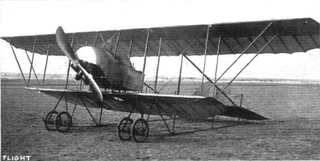Related Research Articles

The Caudron C.27 was a French biplane, a two-seat basic trainer which also competed successfully in the 1920s.
The Caudron C.99 was a French light bomber and reconnaissance aircraft. The only example flew with different engines in the mid-1920s.
The Caudron C.97 was a two-seat biplane trainer designed and built in France around 1924. A number were used by the Bolivian Air Force.

The Caudron C.74 was a ten-seat, four engine passenger biplane built in France in 1922. It showed promise but the sole prototype crashed fatally in a competition and no more were completed.

The Caudron C.68 was a two-seat French training and touring aircraft, built in the early 1920s, which attracted interest at the time because of its simple and fast wing folding arrangement. Only a few were produced.

The Caudron C.67 was a simple single seat biplane with a low powered engine. It was built and flown in France in 1922.

The Caudron C.43 was the first French five-engined aircraft, a biplane intended for passenger transport or military use and multi-engined for safety. A development of the three-engined Caudron C.39, it had one tractor configuration engine in the nose and two push-pull pairs between the wings. It was capable of carrying eight passengers but was not developed.

The Caudron C.39 was a French three-engined biplane with a cabin for six passengers when the aircraft was equipped as a landplane or four passengers when on floats. It was flown with some success in competitions in 1920 and 1921.
The Caudron C.37 was a French three-engined biplane passenger transport, built in 1920. It could carry six passengers.

The Caudron C.33 "Landaulet Monsieur-Madame" was a French twin engined biplane with four seats, two in open cockpits and two in an enclosed cabin.

The Caudron C.25 was a large, three-engined, biplane airliner, designed and built in France soon after the end of World War I. Its enclosed cabin could accommodate up to eighteen passengers.

The Hydroaéroplane Caudron-Fabre, (Caudron-Fabre), was a French amphibious seaplane which competed in the 1912 Monaco event. It was one of the first true amphibians, able to take-off from water and touch down on land.

The Caudron Type L was a two-seat French pusher configuration amphibious biplane, flown around 1913 and intended for naval use.
The Caudron Type B was a 1911 development of the earliest Caudron type, the Caudron Type A, with a nacelle style fuselage and more powerful engine. Initially an equal span biplane, it was modified into a sesquiplane.
The Caudron Type K was a French floatplane with a very powerful, twenty cylinder radial engine in pusher configuration. It took part in a French seaplane competition in 1913, but was lost in a take-off accident during the competition.
The Caudron Type B Multiplace was a large French biplane designed to carry up to five passengers in a cross country time trial of 1912. It was destroyed early in the event.
The Caudron Type C was a single seat French biplane, intended for military evaluation. Two were built in 1911.

The Caudron Type F was a French single seat biplane produced just before World War I. A dozen were bought by China and at least two other examples, with different engines, competed in 1913, coming first and second in the biplane category of the cross-country race at Reims. Flown by Pierre Canteloup, one was the first biplane to loop-the-loop.

The Caudron Type D was a French pre-World War I single seat, twin-boom tractor biplane, a close but slightly smaller relative of the two seat Caudron Type C. More than a dozen were completed, one exported to the United Kingdom, where they may also have been licence built, and three to China.
The Caudron Type E two seat trainer was a larger and more powerful development of the Type C. Two or three were bought by the French military and one by the Royal Navy just before World War I but its sales were overtaken by the superior Type G.
References
- ↑ Hauet, André (2001). Les Avions Caudrons. 1. Outreau: Lela Presse. p. 2. ISBN 2 914017-08-1.
- 1 2 3 4 5 6 7 8 9 10 11 Hauet (2001). Les Avions Caudrons. pp. 39–42.
- 1 2 3 4 "A Tabular Description of the Aeroplanes at the Fourth Paris Salon". Flight . IV (45): 1023. 9 November 1912.
- 1 2 "Quatrième Exposition Internationale de Locomotion Aérienne". L'Aérophile. 20 (22): 509. 15 November 1912.
- 1 2 "The Paris Aero Salon - Caudron". Flight . IV (44): 999. 2 November 1912.